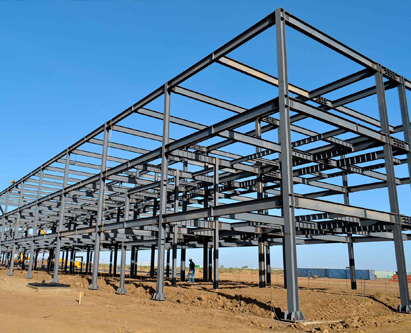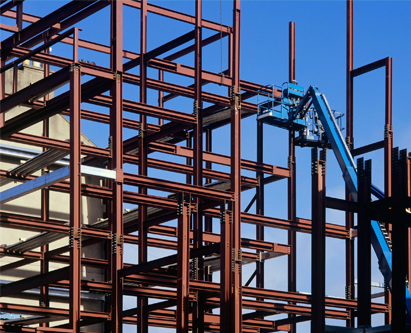Strut Structure is a structure made of steel materials and is one of the main types of building structures. The structure is mainly composed of steel beams, steel columns, steel trusses and other components made of steel sections and steel plates, and adopts rust removal and rust prevention processes such as silanization, pure manganese phosphating, water washing and drying, and galvanizing. Welds, bolts or rivets are usually used to connect the components or parts. Because of its light weight and simple construction, it is widely used in large factories, venues, super high-rise buildings, bridges and other fields. Steel structures are prone to rust. Generally, steel structures need to be rust-free, galvanized or painted, and maintained regularly.
Definition
Steel is characterized by high strength, light weight, good overall rigidity, and strong resistance to deformation, so it is particularly suitable for building large-span, super-high, and super-heavy buildings; the material has good homogeneity and isotropy, and is an ideal elastic body, which best conforms to the basic assumptions of general engineering mechanics; the material has good plasticity and toughness, can have large deformation, and can well withstand dynamic loads; the construction period is short; it has a high degree of industrialization and can be produced with a high degree of mechanization.
Steel structures should study high-strength steel to greatly improve their yield point strength; in addition, new types of steel should be rolled, such as H-shaped steel (also known as wide flange steel) and T-shaped steel and corrugated steel plates to meet the needs of large-span structures and super-high-rise buildings.
In addition, there is a light steel structure system without thermal bridges. The building itself is not energy-saving. This technology uses clever special connectors to solve the problem of cold and hot bridges in the building; the small truss structure allows cables and water pipes to pass through the wall, which is convenient for construction and decoration.
Features
1. High material strength and light weight
Steel has high strength and high elastic modulus. Compared with concrete and wood, its density to yield strength ratio is relatively low. Therefore, under the same stress conditions, the steel structure has a small cross-section and light weight, which is easy to transport and install. It is suitable for structures with large spans, high heights and heavy loads.
2. Steel has good toughness, plasticity, uniform material and high structural reliability
Suitable for bearing impact and dynamic loads, with good seismic resistance. The internal structure of steel is uniform and close to isotropic homogeneous body. The actual working performance of steel structure is more in line with calculation theory. Therefore, the steel structure has high reliability.
3. High degree of mechanization in steel structure manufacturing and installation
Steel structure components are easy to manufacture in factories and assemble on site. The finished products of mechanized steel structure components manufactured in factories are of high precision, high production efficiency, fast assembly speed on site and short construction period. Steel structure is a structure with the highest degree of industrialization.
4. Good sealing performance of steel structure
Since the welded structure can be completely sealed, it can be made into high-pressure containers, large oil tanks, pressure pipes, etc. with good airtightness and watertightness.
5. Steel structure is heat-resistant but not fire-resistant
When the temperature is below 150℃, the properties of steel change little. Therefore, steel structure is suitable for hot workshops, but when the surface of the structure is subjected to heat radiation of about 150℃, it should be protected by heat insulation boards. When the temperature is 300℃-400℃, the strength and elastic modulus of steel will drop significantly. When the temperature is around 600℃, the strength of steel tends to zero. In buildings with special fire protection requirements, steel structures must be protected by refractory materials to improve the fire resistance level.
6. Poor corrosion resistance of steel structure
Especially in humid and corrosive media environments, it is easy to rust. Generally, steel structures need to be rust-proofed, galvanized or painted, and maintained regularly. For offshore platform structures in seawater, special measures such as "zinc block anode protection" are required to prevent corrosion.
7. Low carbon, energy-saving, green and environmentally friendly, reusable
The demolition of steel structure buildings will hardly generate construction waste, and steel can be recycled and reused.
From the magnificent dome of large-span venues to the vertical skyline of super-high-rise buildings, steel structure has become an important symbol of modern architectural civilization with its excellent mechanical properties and industrial advantages. Despite the natural challenges of fire resistance and corrosion resistance, these shortcomings are being overcome one by one with the development of high-strength steel, innovation of anti-corrosion technology and breakthroughs in fire prevention technology. Especially under the guidance of the "dual carbon" goal, steel structure, with its low-carbon, environmentally friendly and recyclable characteristics, is deeply in line with the concept of green building. Its innovative technologies such as thermal bridge-free system and modular construction also indicate the future direction of building industrialization.
When the cold texture of steel is perfectly integrated with architectural art, and when mechanical aesthetics and functionalism are balanced, steel structure has long surpassed the material itself and has become the core force driving urban space transformation. From industrial plants to landmark buildings, from bridge projects to offshore platforms, this "breathing skeleton" is continuing to write a legend of combining rigidity and flexibility in the history of architecture with its infinite adaptability. Looking to the future, with the continuous iteration of material science and construction technology, steel structures will surely support human imagination of space in a wider range of fields, making each building a mark of the times where technology and aesthetics coexist.
Contact Us for More Information
Email: chinaroyalsteel@163.com
whatsApp: +86 153 2001 6383 (Factory General Manager)
Post time: Apr-16-2025




